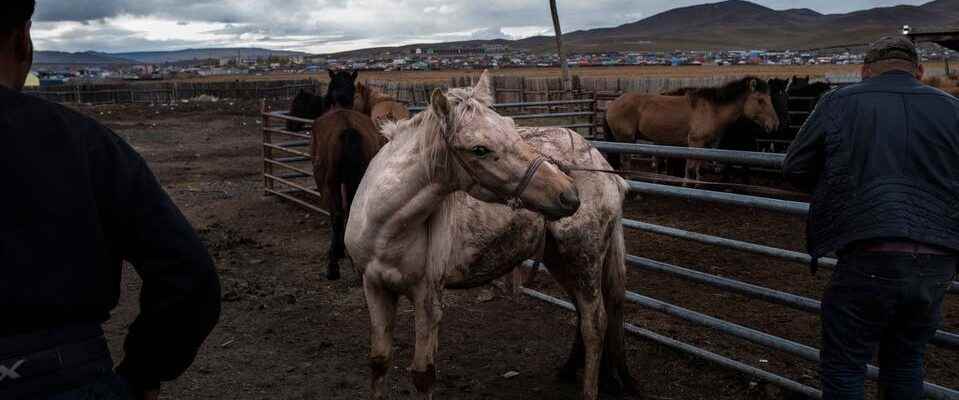Horses are symbols of the nomadic lifestyle of the Mongols and embody forgotten virtues. But today they are no longer respected as they once were. Naranbadrach wants to change that.
It smells like death, the horses feel it. They move restlessly in their small, muddy paddocks and keep looking across to the slaughterhouse, from which there are no noises, but steams of sweet decomposition. Anxious animals show the whites of their eyes, frown and sniff, others dance nervously in place. All of the approximately forty horses here will lose their lives in this slaughterhouse – all but two. Naranbadrach bought it from the butcher and now wants to bring it to his herd.
A winner and a fighter
They are already selected: a bay stallion, handsome and alert, and a white nine-year-old. He’s gaunt, scarred and dirty, and possibly not entirely healthy. But how much life is in him! He distrusts his rescuers, kicks, tugs at the lasso, foams at the mouth, rolls his eyes, grunts and moans. “I’ve been watching him for a long time,” says Naranbadrach. «A fighter. He kicked at the door, at the fence, he demolished half the stable. He wants to live.” He should be called Sergelen, Mongolian for “clever, clever”. The brown has seen better days. He was a well-known racehorse and long ranked in the top five in the championships traditional Naadam race of the district. Songs of praise were sung to him, neck and cheeks sprayed with fermented mare’s milk in solemn ceremony. Then he hurt his leg and the owner sold him to the butcher.
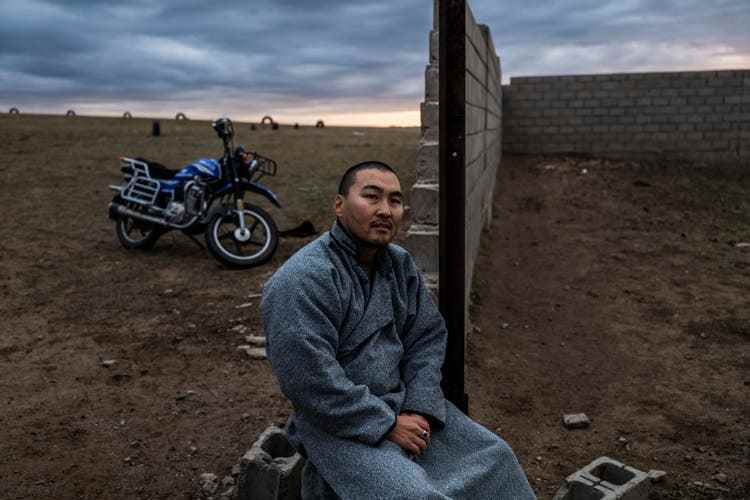
Mongolian cybertech entrepreneur Naranbadrach Batchan launched a campaign against horse slaughter.
It is gloomy and cold in this unnamed place on the northern edge of the Gobi desert. The butcher’s shop is in the Nalaich district, it’s the only one for hundreds of kilometers, everyone knows where it is. Strong men set up ramps and maneuver the two rescued animals patiently and without being rude onto the loading area of a small truck. The gaunt gray soon lays down. “Look at his eyes,” says Naranbadrach. “Now he’s scared and exhausted. But tomorrow he will have a different look. Calm, clear, full of trust.”
Naranbadrach groans a little as he gets behind the wheel of his Land Cruiser. He walks on crutches, he broke his ankle. ‘Me against two horses. I wanted to be stronger, I wasn’t: that’s the punishment. I was stupid.” He grins and we head south towards the Gobi. It was a good day, Naranbadrach is satisfied. For two years he has been buying animals from all over the region, integrating them into his herd of 85 and allowing them to live freely in the wild. He uses a few particularly quiet animals for his work with drug addicts and autistic people. Like many therapists, he is convinced that the sick can find relief in the aura of these large, beautiful, sensitive beings. ‘The horse can talk to you. If you respect it, it becomes your friend. Sounds pathetic, I know. But it is. This friendship can heal people.” His customers come from all over the world.
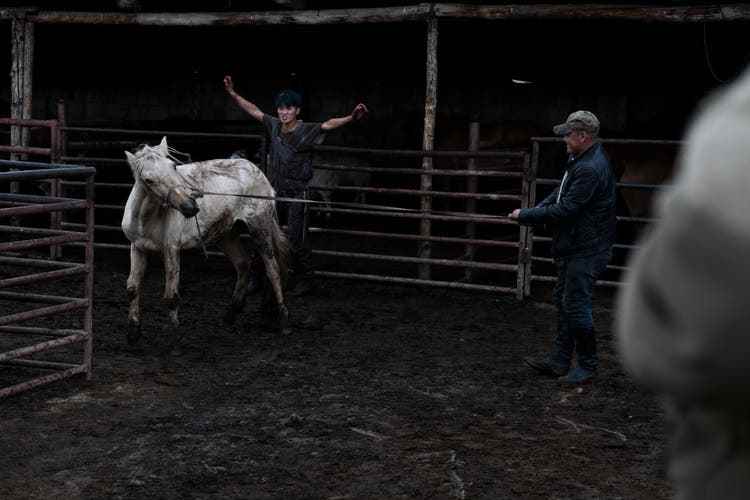
Sergelen braces himself against his rescuers with all his might. “He fights, he wants to live,” says Naranbadrach. So he takes him into his herd.
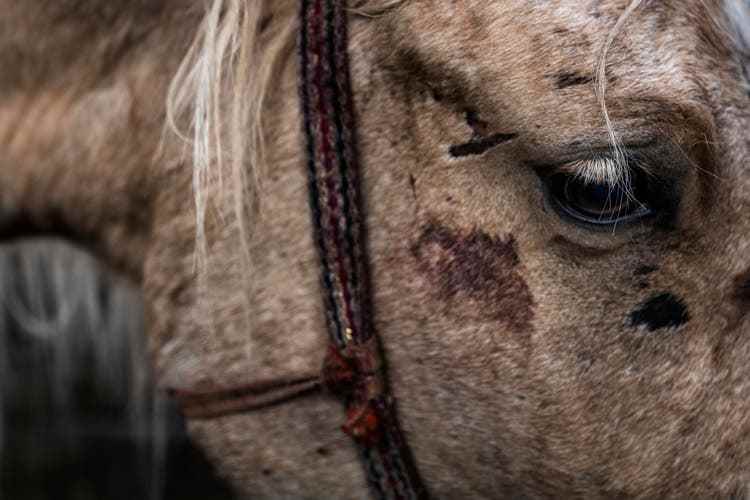
In his desperate struggle for survival, Sergelen has suffered bruises and cuts.
Forgotten Worship
Outside, the rolling hills of the steppe glide past, inside there’s coffee in a cardboard cup. Naranbadrach keeps an eye on the truck with the two horses that are allowed to live, the picture seems to make him happy. The view of the rural Mongolians resembles that of seafarers: it is wide, looking for the horizon. From time to time herds can be seen, mostly goats, sheep, cattle or horses, now and then camels. All graze quietly. The camels walk in a rocking amble, heads held high, munching haughtily.
Cattle, goats and sheep make up the majority of the herd animals, but the horses are the true symbol of Mongolian nomadic life. “They are the basis of our culture,” says Naranbadrach. This little horse is unique: sensitive and willing when kept by people, wild out on the steppes, tough and resistant to cold. “We have always lived with the horses, but the bond used to be closer. Horses were everywhere. They rode out on them, visited each other, herds were herded together. They were given to children to teach them responsibility. A horse matures you. The Mongolian national character is shaped by love and affection. It’s from the horses. We should be good to people, animals and nature. Unfortunately we are not always. We used to pay more attention to horses. Horses were cared for, honored, pampered. They were family members.”
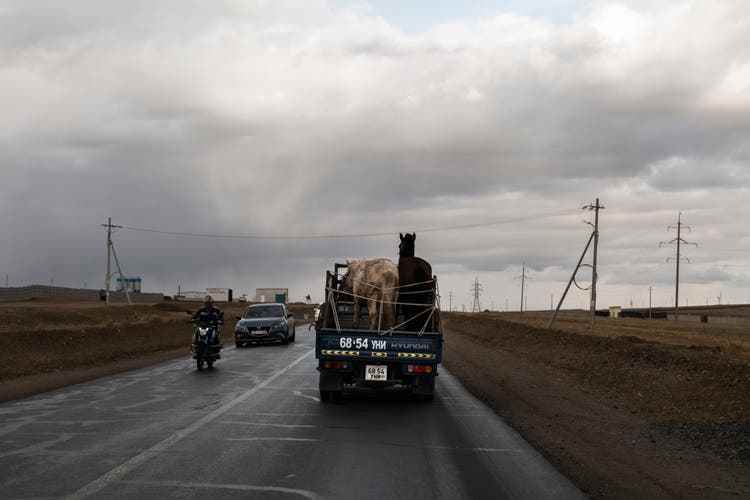
Into the wilderness instead of the slaughterhouse: Naranbadrach and his brother bought two horses from a butcher.
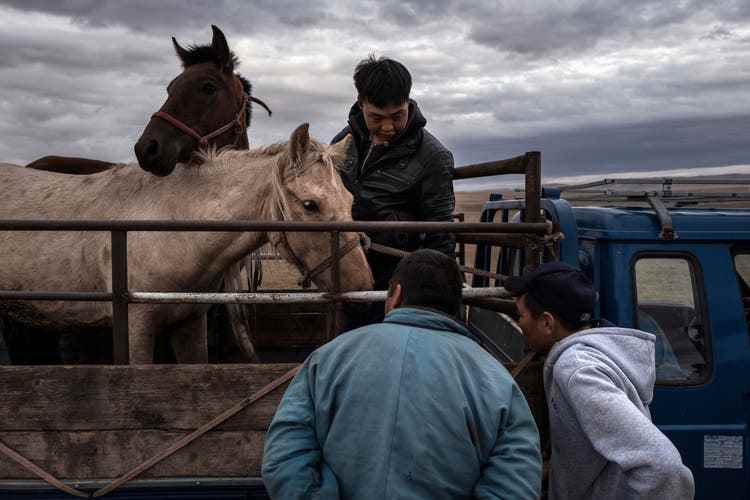
Naranbadrach’s staff talk soothingly to the terrified Sergelen after maneuvering him onto the truck bed. The horse listens intently, ears pricked and forward.
Then the Russians came and everything has changed since then. Stalin needed Mongolian horses for the war against the Nazis. They were more enduring and less sensitive to cold than European horses, they were not to be beaten. “The Russians took a million horses from us,” says Naranbadrach. ‘They ate horse meat. We took that on. Until 1915, the Mongols did not eat horse meat at all. The Russians changed that, we allowed it. Traditional nomadic life has been destroyed.” One cannot help but get the impression that the Russians are being blamed for a development that also has numerous other causes. But there is no doubt that Soviet-style socialism had a strong influence on the nomadic country, and that to this day Russians remember the achievements of Mongolian horses in war with admiration. Since 2017 stands in Moscow’s Victory Park Monument in honor of Mongolian help to Moscow during the war against Nazi Germany in the form of food, strong horses, warm clothing and military equipment. It shows two horses dragging a gun.
Tradition and modernity combined
Perhaps Naranbadrach is somewhat mystifying about his Mongolian horses. But actually he is a sober man of numbers. “I don’t earn anything with the horses.” Responsible for the cash flow is his company registered in Dubai, which offers «IT solutions», more specifically: data encryption for the demanding, an important customer is the Mongolian army. He comes from the country but studied and lived in Ulaanbaatar for eighteen years. In Mongolia he is known as a sore thumb, mainly because of his commitment to the animals. His campaign against horse slaughter, launched two years ago, has been popular with the townspeople. And he’s successful. The president supports him, families with children who want to ride horses come from Ulaanbaatar every weekend, and the UN has his Mongolian Horse Paradise Initiative receive an award that rewards sustainable projects. A modern Mongolian rooted in tradition.
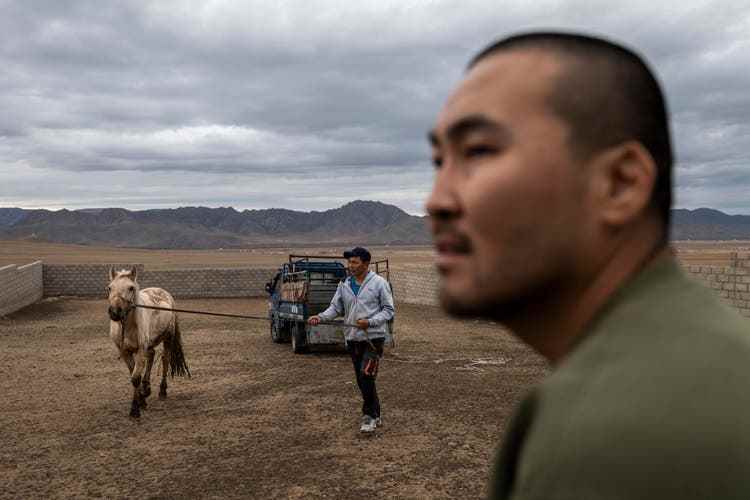
Far out in the steppe, in a paddock made of concrete blocks, Sergelen is unloaded. He’s still nervous, but no longer scared.
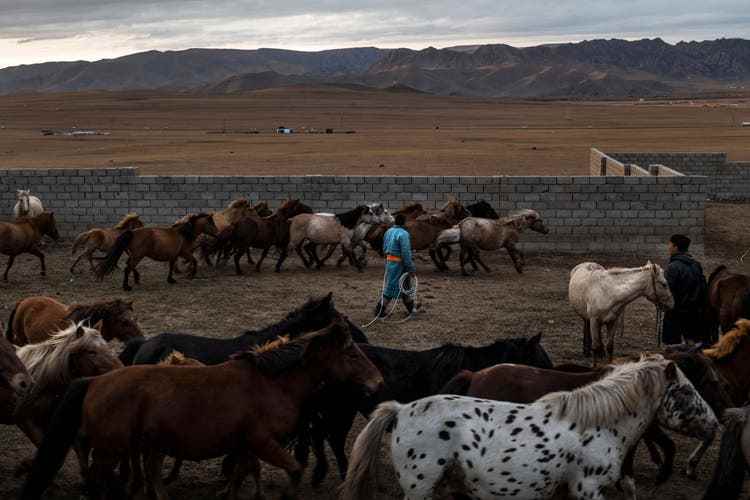
Sergelen stands there tired and surrendered and is surrounded by the herd, into which he will soon integrate. Naranbadrach uses particularly calm animals for his work with drug addicts and autistic people.
It’s getting dark and cold on the steppe, the cracks on the hills are already black. Sergelen and the bay are unloaded. They do a few laps and then look intently to the west, where in the light stripe above the horizon first a horse’s head appears, then another, then torsos and finally a wall of steaming bodies: the herd of Naranbadrachs. Ochirbar, the horse rescuer’s younger brother, has tracked them down and is now driving them toward the jagged concrete paddock where we wait at the entrance. What could be more impressive than a hundred trotting horses with waving manes? It is a truly majestic arrival and yet a discreet one: the steppe swallows almost all sounds. Conducted willingly and skilfully by Ochirbar on his Chinese Haojue 160 cm3-Motorcycle, the animals run into the paddock. They’re not nervous, they know the procedure.
Back to freedom
In the concrete labyrinth they trot up and down, sometimes leisurely, then quickly again, as if trying to escape. It is an incessant surge and flow, a snort and snort. When a group takes off, the ground shakes. Three sub-groups make up the herd, led by stallions with approximately equal numbers of females and males. They get along well with each other, ranking fights are rare, although very few stallions are castrated. The ribs are visible on many a bulging horse’s belly: the steppe is barren in these months, there is not much to eat. With the lasso, Ochirbar catches a bay stallion. It is strong, climbs, whinnies and pulls, but has no chance: Ochirbar presses his feet into the ground and casually lets himself be dragged a few meters until the animal calms down. Then it is coupled with Sergelen on the head, from now on the two have to walk and eat in step. This forced community lasts eight to nine days, “that’s how they become friends,” says Naranbadrach. After that, Sergelen will be accepted as a member of the herd. “A few more scuffles, and then it’s quiet.”
Naranbadrach has thrown on a Mongolian shepherd’s cloak, and from a distance one could mistake him for a Tibetan monk. He deliberately sits down on a wall, stretches his injured leg and says nothing. What’s there to say? the night is coming A little wind talks and tugs at things. On the horizon, a herd of camels wanders south. Venus is shining in the west, with an airplane blinking right next to it. The horses leave the paddock purposefully and disappear into the darkness. If nothing worries them, they will stay close, easily spotted by Ochirbar on his motorbike. A little owl calls nearby. One might think that there is nothing but peace in this world.

